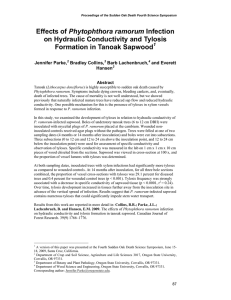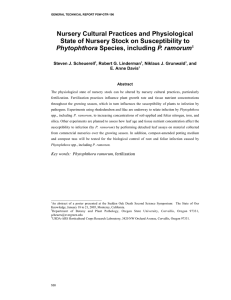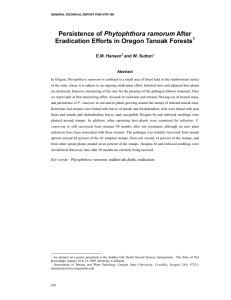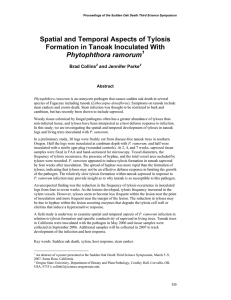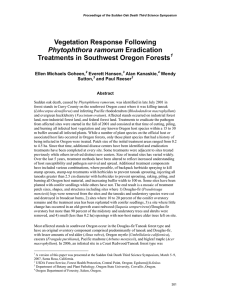Phytophthora ramorum Sapwood and is Associated With Reduced Xylem
advertisement
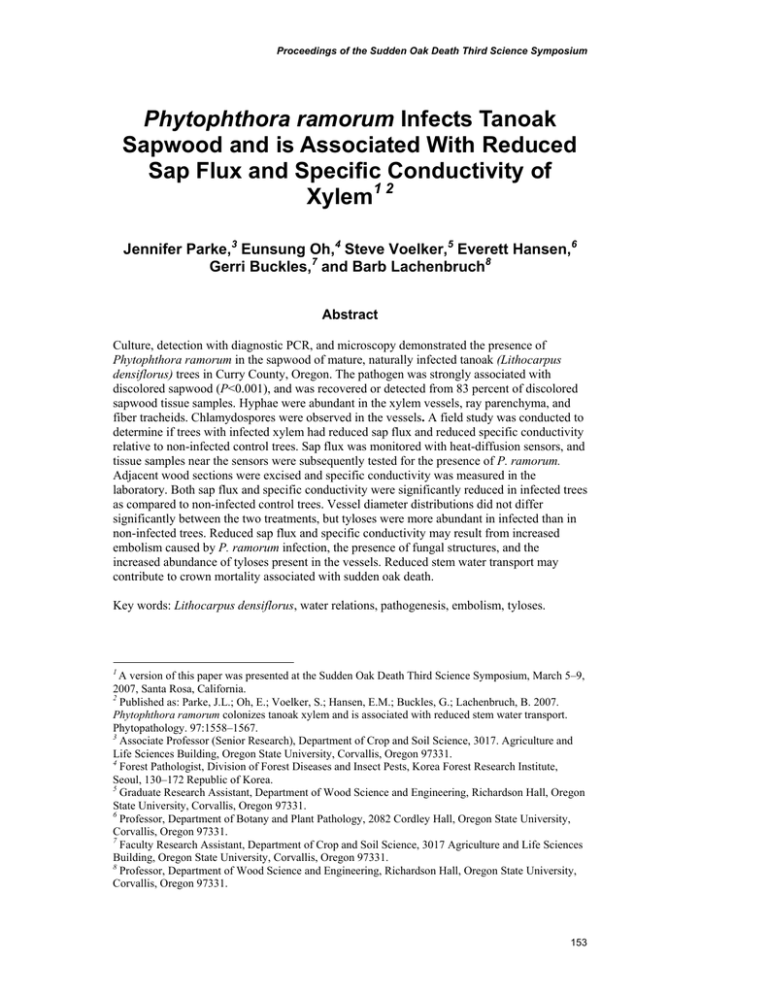
Proceedings of the Sudden Oak Death Third Science Symposium Phytophthora ramorum Infects Tanoak Sapwood and is Associated With Reduced Sap Flux and Specific Conductivity of Xylem1 2 Jennifer Parke,3 Eunsung Oh,4 Steve Voelker,5 Everett Hansen,6 Gerri Buckles,7 and Barb Lachenbruch8 Abstract Culture, detection with diagnostic PCR, and microscopy demonstrated the presence of Phytophthora ramorum in the sapwood of mature, naturally infected tanoak (Lithocarpus densiflorus) trees in Curry County, Oregon. The pathogen was strongly associated with discolored sapwood (P<0.001), and was recovered or detected from 83 percent of discolored sapwood tissue samples. Hyphae were abundant in the xylem vessels, ray parenchyma, and fiber tracheids. Chlamydospores were observed in the vessels. A field study was conducted to determine if trees with infected xylem had reduced sap flux and reduced specific conductivity relative to non-infected control trees. Sap flux was monitored with heat-diffusion sensors, and tissue samples near the sensors were subsequently tested for the presence of P. ramorum. Adjacent wood sections were excised and specific conductivity was measured in the laboratory. Both sap flux and specific conductivity were significantly reduced in infected trees as compared to non-infected control trees. Vessel diameter distributions did not differ significantly between the two treatments, but tyloses were more abundant in infected than in non-infected trees. Reduced sap flux and specific conductivity may result from increased embolism caused by P. ramorum infection, the presence of fungal structures, and the increased abundance of tyloses present in the vessels. Reduced stem water transport may contribute to crown mortality associated with sudden oak death. Key words: Lithocarpus densiflorus, water relations, pathogenesis, embolism, tyloses. 1 A version of this paper was presented at the Sudden Oak Death Third Science Symposium, March 5–9, 2007, Santa Rosa, California. 2 Published as: Parke, J.L.; Oh, E.; Voelker, S.; Hansen, E.M.; Buckles, G.; Lachenbruch, B. 2007. Phytophthora ramorum colonizes tanoak xylem and is associated with reduced stem water transport. Phytopathology. 97:1558–1567. 3 Associate Professor (Senior Research), Department of Crop and Soil Science, 3017. Agriculture and Life Sciences Building, Oregon State University, Corvallis, Oregon 97331. 4 Forest Pathologist, Division of Forest Diseases and Insect Pests, Korea Forest Research Institute, Seoul, 130–172 Republic of Korea. 5 Graduate Research Assistant, Department of Wood Science and Engineering, Richardson Hall, Oregon State University, Corvallis, Oregon 97331. 6 Professor, Department of Botany and Plant Pathology, 2082 Cordley Hall, Oregon State University, Corvallis, Oregon 97331. 7 Faculty Research Assistant, Department of Crop and Soil Science, 3017 Agriculture and Life Sciences Building, Oregon State University, Corvallis, Oregon 97331. 8 Professor, Department of Wood Science and Engineering, Richardson Hall, Oregon State University, Corvallis, Oregon 97331. 153
